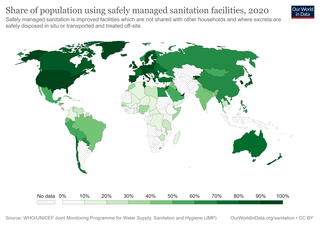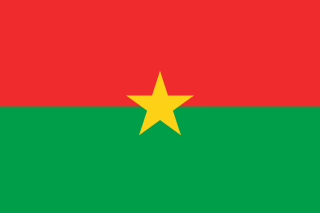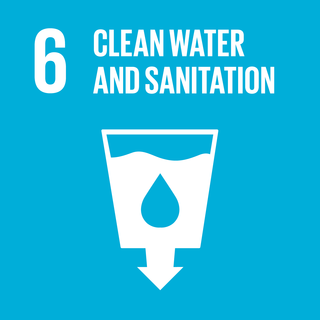
Sanitation refers to public health conditions related to clean drinking water and treatment and disposal of human excreta and sewage. Preventing human contact with feces is part of sanitation, as is hand washing with soap. Sanitation systems aim to protect human health by providing a clean environment that will stop the transmission of disease, especially through the fecal–oral route. For example, diarrhea, a main cause of malnutrition and stunted growth in children, can be reduced through adequate sanitation. There are many other diseases which are easily transmitted in communities that have low levels of sanitation, such as ascariasis, cholera, hepatitis, polio, schistosomiasis, and trachoma, to name just a few.

Drinking water or potable water is water that is safe for ingestion, either when drunk directly in liquid form or consumed indirectly through food preparation. It is often supplied through taps, in which case it is also called tap water. Typically in developed countries, tap water meets drinking water quality standards, even though only a small proportion is actually consumed or used in food preparation. Other typical uses for tap water include washing, toilets, and irrigation. Greywater may also be used for toilets or irrigation. Its use for irrigation however may be associated with risks.

United Nations Water (UN-Water) is an interagency mechanism that coordinates the efforts of United Nations entities and international organizations working on water and sanitation issues.
The Multiple Indicator Cluster Surveys (MICS) are household surveys implemented by countries under the programme developed by the United Nations Children's Fund to provide internationally comparable, statistically rigorous data on the situation of children and women. The first round of surveys (MICS1) was carried out in over 60 countries in mainly 1995 and 1996 in response to the World Summit for Children and measurement of the mid-decade progress. A second round (MICS2) in 2000 increased the depth of the survey, allowing monitoring of a larger number of globally agreed indicators. A third round (MICS3) started in 2006 and aimed at producing data measuring progress also toward the Millennium Development Goals (MDGs), A World Fit for Children, and other major relevant international commitments. The fourth round, launched in 2009, aimed at most data collection conducted in 2010, but in reality most MICS4s were implemented in 2011 and even into 2012 and 2013. This represented a scale-up of frequency of MICS from UNICEF, now offering the survey programme on a three-year cycle. The fifth round, launched in 2012, was aimed at offering countries the tools to do the final MDG data collection.

Sustainable sanitation is a sanitation system designed to meet certain criteria and to work well over the long-term. Sustainable sanitation systems consider the entire "sanitation value chain", from the experience of the user, excreta and wastewater collection methods, transportation or conveyance of waste, treatment, and reuse or disposal. The Sustainable Sanitation Alliance (SuSanA) includes five features in its definition of "sustainable sanitation": Systems need to be economically and socially acceptable, technically and institutionally appropriate and protect the environment and natural resources.

Water supply and sanitation in Rwanda is characterized by a clear government policy and significant donor support. In response to poor sustainability of rural water systems and poor service quality, in 2002 local government in the Northern Byumba Province contracted out service provision to the local private sector in a form of public–private partnership. Support for public-private partnerships became a government policy in 2004 and locally initiated public-private partnerships spread rapidly, covering 25% of rural water systems as of 2007.

An improved water source is a term used to categorize certain types or levels of water supply for monitoring purposes. It is defined as a type of water source that, by nature of its construction or through active intervention, is likely to be protected from outside contamination, in particular from contamination with fecal matter.

Improved sanitation is a term used to categorize types of sanitation for monitoring purposes. It refers to the management of human feces at the household level. The term was coined by the Joint Monitoring Program (JMP) for Water Supply and Sanitation of UNICEF and WHO in 2002 to help monitor the progress towards Goal Number 7 of the Millennium Development Goals (MDGs). The opposite of "improved sanitation" has been termed "unimproved sanitation" in the JMP definitions. The same terms are used to monitor progress towards Sustainable Development Goal 6 from 2015 onwards. Here, they are a component of the definition for "safely managed sanitation service".
The Water, Sanitation and Hygiene Monitoring Program or WaSH MP is a local initiative that is responsible for monitoring the enduring crisis in the water sector in the Palestinian territories (oPt).
Drinking water supply and sanitation in Pakistan is characterized by some achievements and many challenges. In 2020, 68% Pakistanis, 72% Indians, 54% Bangladeshi had access to the basic sanitation facilities. Despite high population growth the country has increased the share of the population with access to an improved water source from 85% in 1990 to 92% in 2010, although this does not necessarily mean that the water from these sources is safe to drink. The share with access to improved sanitation increased from 27% to 38% during the same period, according to the Joint Monitoring Program for Water Supply and Sanitation. There has also been considerable innovation at the grass-root level, in particular concerning sanitation. The Orangi Pilot Project in Karachi and community-led total sanitation in rural areas are two examples of such innovation.

Water supply and sanitation in Tanzania is characterised by: decreasing access to at least basic water sources in the 2000s, steady access to some form of sanitation, intermittent water supply and generally low quality of service. Many utilities are barely able to cover their operation and maintenance costs through revenues due to low tariffs and poor efficiency. There are significant regional differences and the best performing utilities are Arusha and Tanga.

Water supply and sanitation in Burkina Faso are characterized by high access to water supply in urban areas, while access to an at least basic water sources in rural areas – where three quarters of the population live – remains relatively low. An estimated one third of water facilities in rural areas are out of service because of a lack of maintenance. Access to at least basic sanitation lags significantly behind access to water supply.
Water Point Mapping (WPM) is a tool for monitoring the distribution and status of water supplies. It collects data about different aspects related to the water facility and overlays this point data with information about population and administrative boundaries. WPM helps to visualize the spatial distribution of water supply coverage and can thereby be used to highlight equity issues. The information collected provides insights into schemes' sustainability levels and management-related aspects of water points.

Although access to water supply and sanitation in sub-Saharan Africa has been steadily improving over the last two decades, the region still lags behind all other developing regions. Access to improved water supply had increased from 49% in 1990 to 68% in 2015, while access to improved sanitation had only risen from 28% to 31% in that same period. Sub-Saharan Africa did not meet the Millennium Development Goals of halving the share of the population without access to safe drinking water and sanitation between 1990 and 2015. There still exists large disparities among sub-Saharan African countries, and between the urban and rural areas.

WASH is a sector in development cooperation or within local governments that provides water, sanitation, and hygiene services to people. The main purposes of providing access to WASH services include achieving public health gains, implementing the human right to water and sanitation, reducing the burden of collecting drinking water for women, and improving education and health outcomes at schools and health facilities. Access to WASH services is also an important component of water security. Universal, affordable, and sustainable access to WASH is a key issue within international development and is the focus of the first two targets of Sustainable Development Goal 6. Targets 6.1 and 6.2 aim for equitable and accessible water and sanitation for all. In 2017, it was estimated that 2.3 billion people live without basic sanitation facilities, and 844 million people live without access to safe and clean drinking water. The acronym WASH is used widely by non-governmental organizations and aid agencies in developing countries.

Water supply in Sierra Leone is characterized by limited access to safe drinking water. Despite efforts by the government and numerous non-governmental organizations, access has not much improved since the end of the Sierra Leone Civil War in 2002, stagnating at about 50% and even declining in rural areas. In the capital Freetown, taps often run dry. It is hoped that a new dam in Orugu, for which China committed financing in 2009, will alleviate water scarcity.

The 2030 Agenda for Sustainable Development, adopted by all United Nations members in 2015, created 17 world Sustainable Development Goals (SDGs). They were created with the aim of "peace and prosperity for people and the planet..." – while tackling climate change and working to preserve oceans and forests. The SDGs highlight the strong interconnections between the environmental, social and economic aspects of sustainable development. Sustainability is at the center of the SDGs.

Open defecation is the human practice of defecating outside rather than into a toilet. People may choose fields, bushes, forests, ditches, streets, canals, or other open spaces for defecation. They do so either because they do not have a toilet readily accessible or due to archaic traditional cultural practices. The practice is common where sanitation infrastructure and services are not available. Even if toilets are available, behavior change efforts may still be needed to promote the use of toilets. 'Open defecation free' (ODF) is a term used to describe communities that have shifted to using toilets instead of open defecation. This can happen, for example, after community-led total sanitation programs have been implemented.

Sustainable Development Goal 6 declares the importance of achieving "clean water and sanitation for all". It is one of the 17 Sustainable Development Goals established by the United Nations General Assembly to succeed the former Millennium Development Goals (MDGs). According to the United Nations, the overall goal is to: "Ensure availability and sustainable management of water and sanitation for all." The goal has eight targets to be achieved by 2030 covering the main areas of water supply and sanitation and sustainable water resource management. Progress toward the targets will be measured by using eleven indicators.














